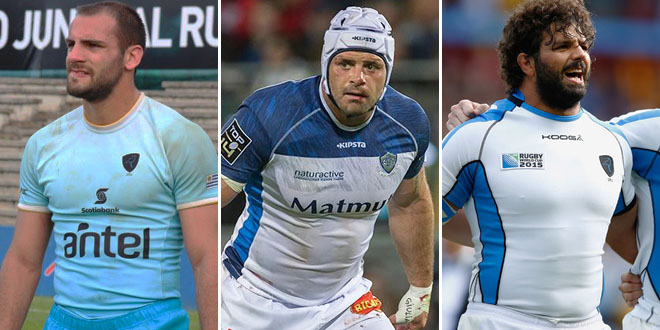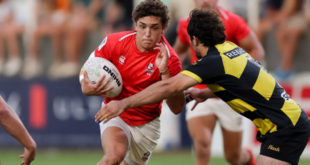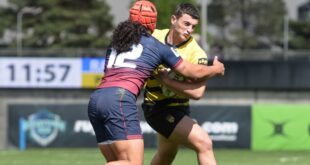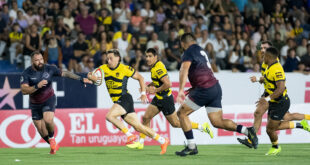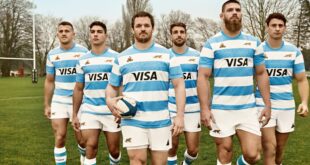Debate inevitably follows each Rugby World Cup squad announcement. Thus far we have looked at the missing men of Argentina and Canada. Today we examine Uruguay, with the USA to follow tomorrow. Players eligible include all those who remain active, including those injured, retired from international duty, or simply overlooked.
Esteban Meneses said that he believes he is taking the best 31 rugby players available to Uruguay to Japan. For the most part we agree, with the back row realistically the only potential bone of contention. There are, however, some players not traveling who we feel could have boosted the squad.
1 – Matías Benítez (Champagnat) The top three loosehead props available are headed to Japan. A handful of alternatives are on the depth chart, with Benítez being the most experienced with 31 test caps. He is now 31 years old, however, and has never really challenged for a first choice spot. The next ‘cabs off the rank’ are a pair of youngsters – Santiago Bonasso and Ezequiel Ramos. Both were part of this year’s u20 Trophy squad and should challenge for spots in the next World Cup cycle.
2 – Carlos Arboleya (Trébol) Enjoying semi-retirement, the former Teros captain was first choice rake at the RWC 2015. Now 34 years old, he remains active for Trébol and could have been a useful addition to the squad for both experience and his ability to cover across the front row. His understudy Germán Kessler has taken over the role as top hooker, and it’s 22-year-old Guillermo Pujadas who goes as backup. Both deserve their spots. Ones to watch in the future are Yamandú Arburúas and this year’s u20 starter Juan Martín Rippe.
3 – Mario Sagario (Carrasco Polo) It came as something of a surprise that Sagario opted to retire from international rugby instead of anchoring the Teros scrum in Japan. Most expected the end to come following the tournament. There are able deputies in Juan Pedro Rombys and Juan Echeverría taking the trip, but neither are of the class of Sagario. Diego Arbelo is the third tighthead taken, a big man who would benefit from a year or two in a professional environment. The heayweight trio at the u20 level – Faustino Etchegorry, Ignacio Péculo, and Reinaldo Piussi – are the future.
4 – Rodrigo Capó Ortega (Castres, FR) The Teros legend suited up for Castres just 10 days ago in the Top 14. His reason for pulling out of the squad was that he would be unfit to play a full part in the World Cup preparations due to a back injury. In slightly different circumstances Georgia have called upon Mamuka Gorgodze, and it’s a shame that Capó Ortega was not a late inclusion to the final 31 if only to be a bench player with Ignacio Dotti and Manuel Leindekar certain to start. There remains a chance that Capó Ortega will play if injury strikes but it now seems that the great man has played his final test for his country.
5 – Diego Ayala (MVCC) Uruguay are lacking a bit in size beyond Dotti and Leindekar, with Manuel Diana the next tallest forward at 1.90m (6’3″). Ayala is a more traditional second row, of genuine international size at 1.99m (6’6″), but his relative lack of mobility meant that Diego Magno and Franco Lamanna, both capable of playing in the back row, were preferred options. Felipe Aliaga is a future international but a couple inches shorter than Ayala and with lots of filling out still to do.
6 – Juanjuan Garese (Carrasco Polo) Second row and captain of the u20s, Garese recently turned down an academy offer in France to stay in Uruguay and play in the new South American pro league. At 1.95m (6’5″) he has above average height but is very lean and at the moment more suited to the flank at senior level. If a traditional openside option were preferred, we would nominate Diego Ardao – whose younger brother Manuel made the cut. Diego is more of a sevens specialist and looks less likely to break into the test side with Manuel jumping ahead in the queue.
7 – Leandro Segredo (Old Christians) The ’32nd man’ – the player closest to selection who was not called. We anticipated his inclusion on the blindside flank but the rise of Santiago Civetta, the versatility of Juan Diego Ormaechea, and the return of Lamanna meant that Segredo was the odd man out. He remains a player of interest given his aggression in the contact area. Flanker is fast becoming the most congested position in the Uruguayan depth chart.
8 – Gonzalo Soto Mera (Carrasco Polo) One spot behind Segredo in the unlucky department. Soto Mera’s ability to play lock or the back row made him a strong candidate for selection, but Lamanna’s return from injury bumped the younger man out. In a perfect world Soto Mera is a loose forward and a quality jumper at the back of the lineout. With Los Teros struggling to find tall players Soto Mera has spent much of his recent time at lock, which may have hindered his development.
9 – Joaquín Alonso (Old Boys) A sevens specialist until only recently, Alonso is very quick across the ground and has the potential to challenge for a spot in the future. Tomás Inciarte’s size and ability to also play in the midfield puts him ahead for now. Guillermo Lijtenstein remains the most experience alternative if needed, while Trébol clubmate Lucas Durán can play both halfback positions. Alfonso Cat and Ignacio Rodríguez are the top prospects emerging from the age grade system.
10 – Andrés De León (Old Christians) It took a long time for De León to win his first cap and though he didn’t disappoint, he also wasn’t quite convincing enough to challenge the top contenders. He is a capable alternative if needed, particularly with his excellent kicking game. Germán Albanell is a similar player to Duran in that he can play No9 or No10 and is a quality goal kicker but very small in stature. Juan Martín Cattivelli impressed with the u20s in 2018 with his ability to take on the line or distribute.
11 – Ignacio García (PSG) The last back to be cut but given his classification as a specialist winger it’s unsurprising. García is quick with good footwork but lacks a little in size and is likely to be soon overtaken by some of the younger talents coming through the age-grade system. The most notable is Old Boys prospect Baltazar Amaya, who turned heads at the u20 Trophy with his speed and determination with ball in hand. Amaya also has the frame to succeed at test level.
12 – Matías D’Avanzo (Old Boys) Another who we might have included as a No10 option but instead we’ve opted to pick as our No12. D’Avanzo played flyhalf for this year’s u20s and showed an array of skills including the ability to kick off either foot. He is shorter and stockier than Cattivelli and could do a job as a second five-eighth style player. Both of Uruguay’s more traditional hard-running inside centres are named in the squad – first choice Andrés Vilaseca and his understudy Agustín Della Corte.
13 – Joaquín Prada (Los Cuervos) Were it not for his medical school commitments, Prada would have many more than his 52 caps and would certainly have been on the plane. He has been an outstanding servant for Uruguayan rugby and is a classy player in both skill and temperament. Inciarte is the beneficiary who also covers scrumhalf. Otherwise it would have been Rodrigo Silva or Federico Favaro tasked to provide emergency cover if needed.
14 – Juan Pablo Costabile (Old Christians) The same criticism applied to García in terms of size could be dealt here, with Costabile even smaller than García but perhaps a nose faster. He has already been capped at senior level while also playing well for the u20s, though Amaya may have stole his thunder somewhat in Brazil. Martín Fitipaldo is another lightning-quick winger who is two years ahead in age but again of similar stature to García and Costabile.
15 – Manuel Blengio (Old Christians) A member of the RWC 2015 squad, Blengio has 21 caps but has never quite pushed beyond being a versatile bench option. His ability to play both flyhalf and fullback is matched by the smaller but more adventurous Felipe Etcheverry, whose late push has been rewarded with a spot on the plane. There are other talented players emerging such as José Iruleguy, but the established veterans Silva and Gastón Mieres still have plenty left in their legs.
 Americas Rugby News Rugby news from across the Americas!
Americas Rugby News Rugby news from across the Americas!
